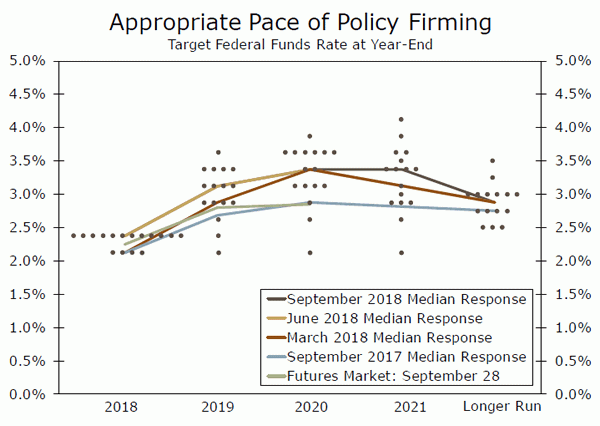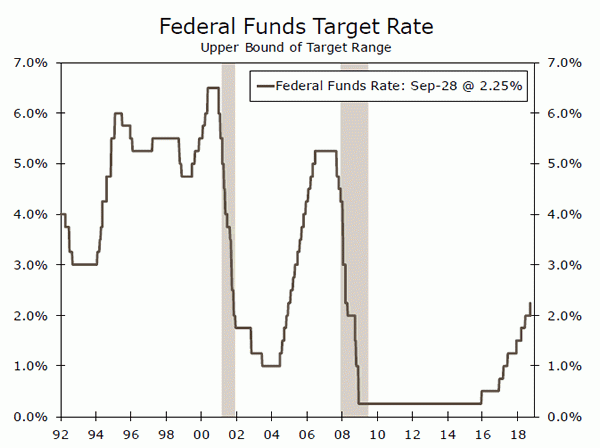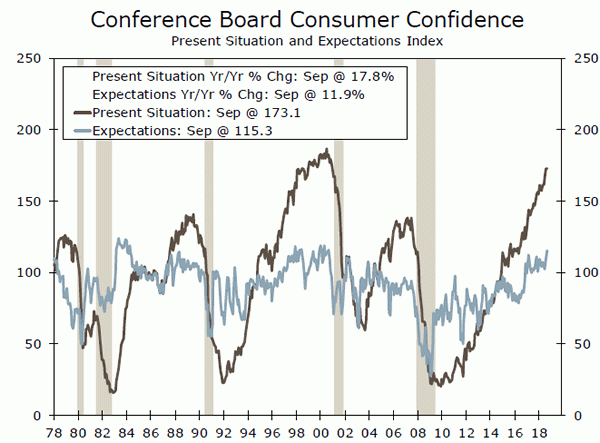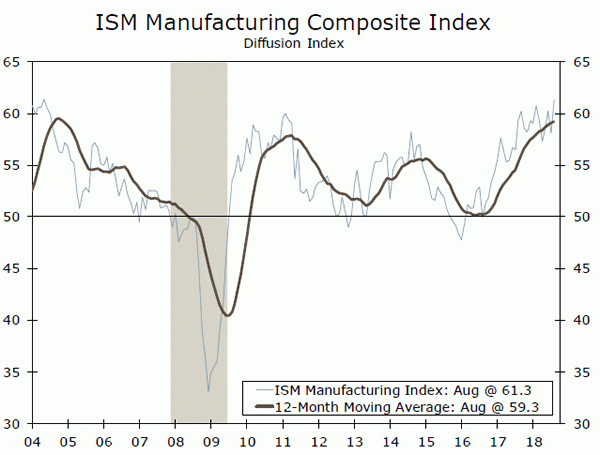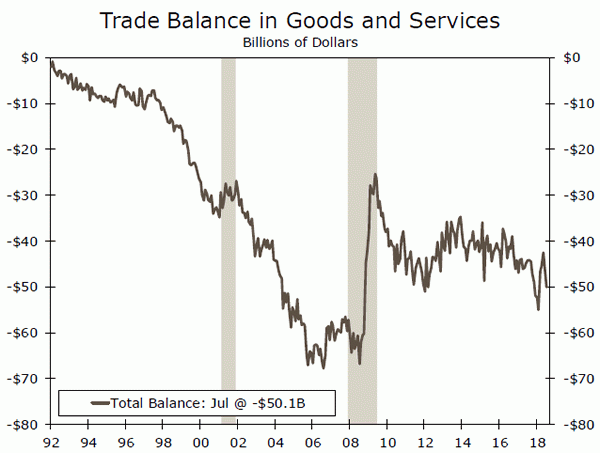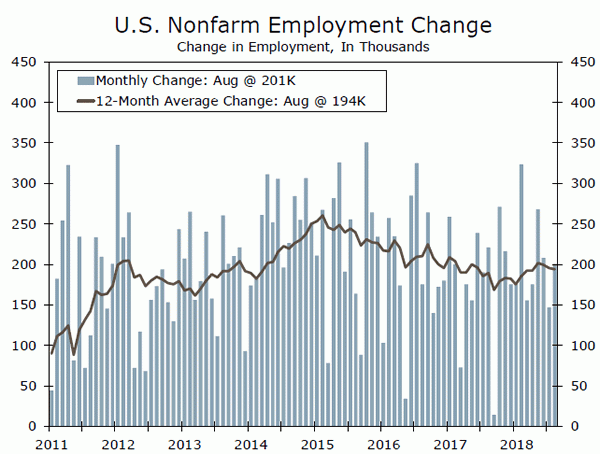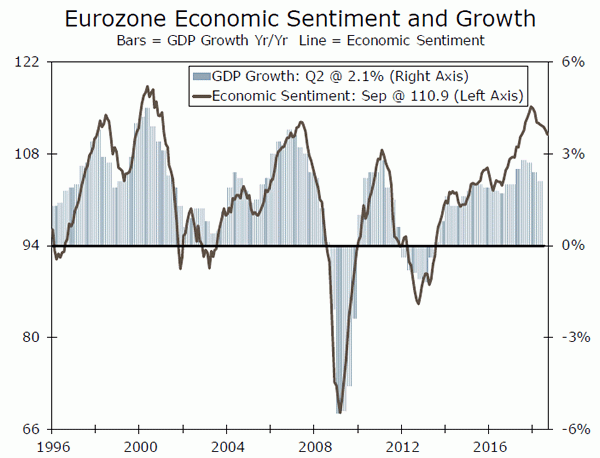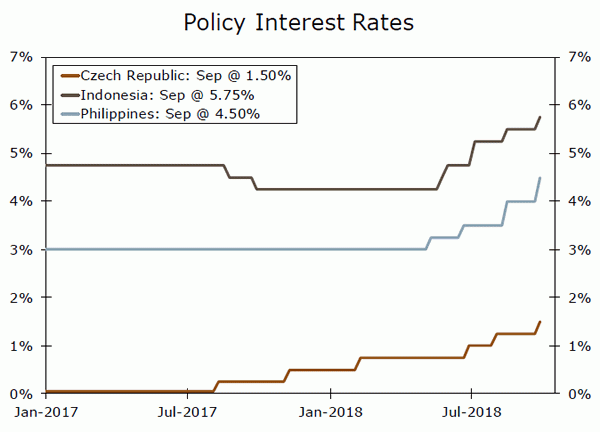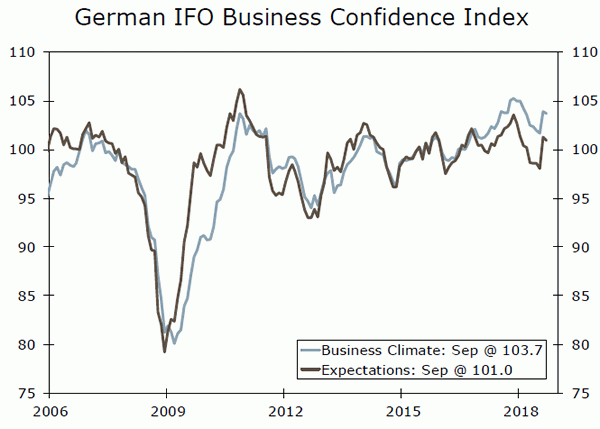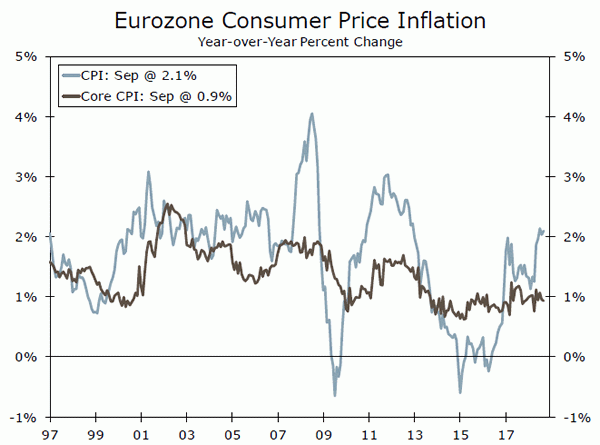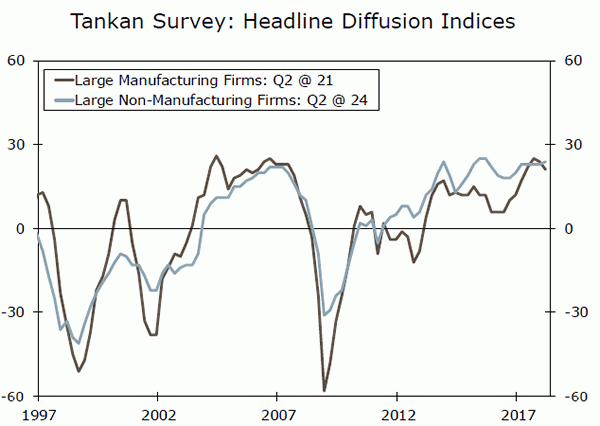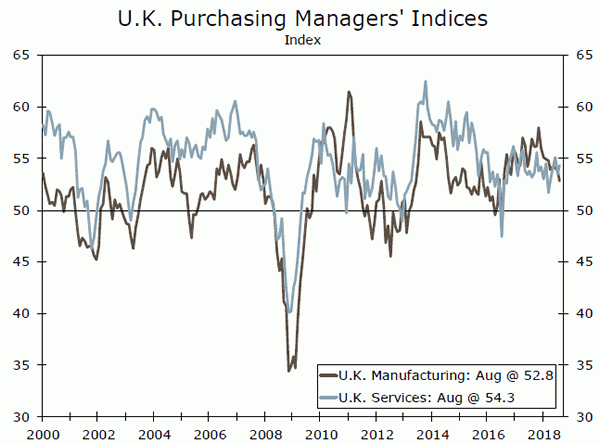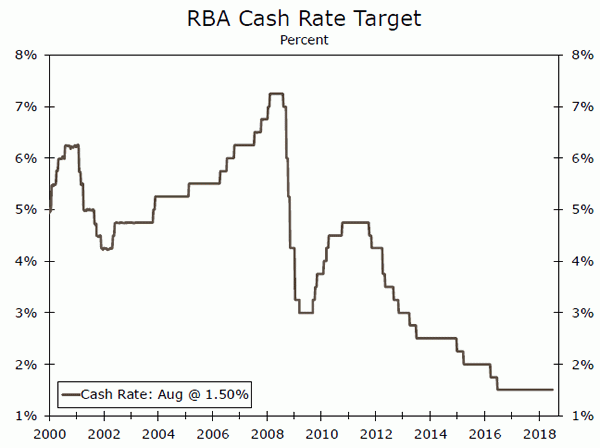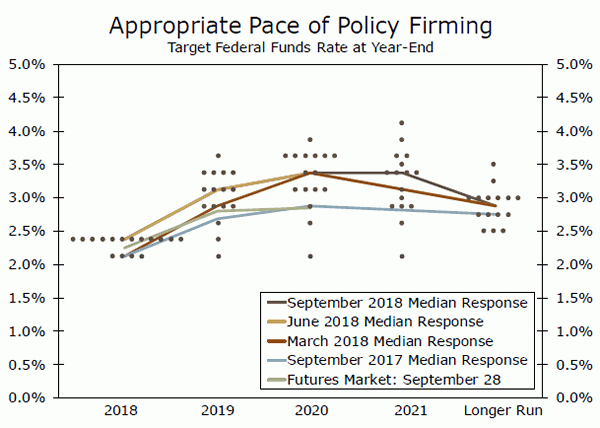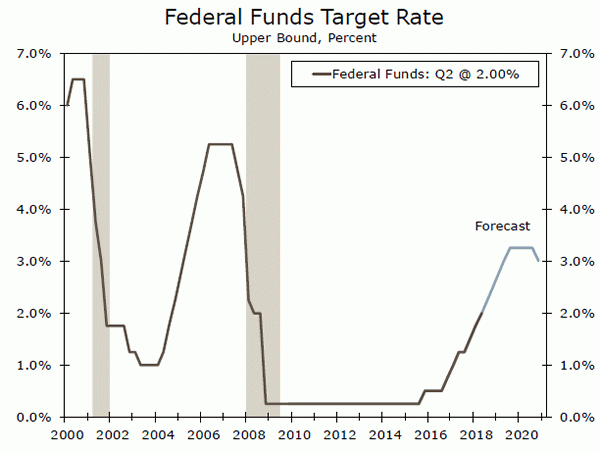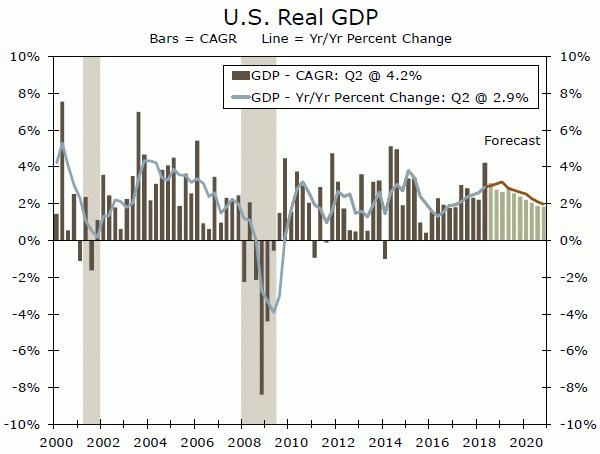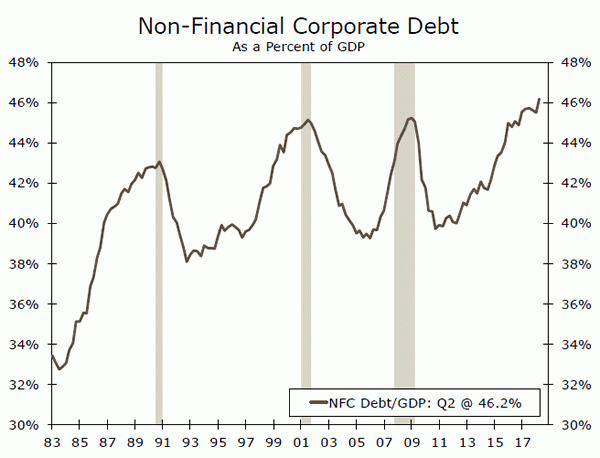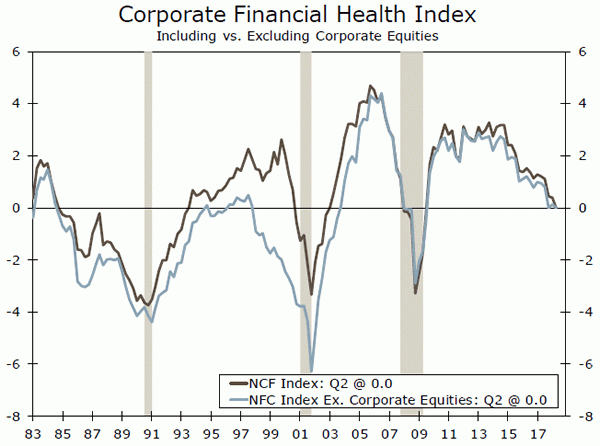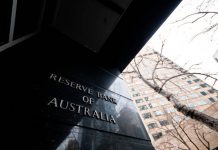U.S. Review
Fed Rate Hike Took Center Stage This Week
- The Federal Open Market Committee (FOMC) raised the fed funds rate 25 bps this week in a widely-expected move. The removal of language characterizing monetary policy as “accommodative” in its statement signals that FOMC members recognize that the funds rate has moved into neutral territory.
- The consumer confidence index neared an all-time high in September, while personal income and spending data released this week generally support consumers’ upbeat sentiment surrounding the near-term outlook.
- New home sales and durable goods orders data look a bit less impressive once we look beneath the headline gains.
Fed Rate Hike Took Center Stage This Week
The FOMC decision was the headline event this week, even though its unanimous 25 bps rate hike was widely expected. What was decidedly more interesting were key changes in the language of the committee’s policy statement, as well as the rollout of its 2021 fed funds rate projections (see chart on first page). While the FOMC has been steadily increasing interest rates since late 2015 (top chart), it has kept language in its statement to say that “monetary policy remains accommodative.” However, that language disappeared this week, meaning the committee is implicitly signaling that the fed funds rate has moved into neutral territory. That said, the neutral fed funds rate estimate is not precise and could take on a broad range. Indeed, the median FOMC member still looks for another 25 bps rate hike before year-end and 75 bps of tightening next year, in line with our own forecast. The FOMC also upped its median GDP growth projections, now at 3.1% this year and 2.5% in 2019, up from 2.8% and 2.4% previously.
Actions this week reinforce the Fed’s view of a strong domestic economy, a tight labor market and on-target inflationary pressures. Indeed, data released today showed that the PCE deflator rose 2.2% in August year-over-year, just above the Fed’s 2% target. Our own forecasts tend to move with the Fed’s in the near term. However, we look for fading fiscal stimulus and passthrough effects of monetary tightening to the broader economy to eventually slow growth and lead the Fed to cut the fed funds rate 25 bps at the end of 2020. We acknowledge that our vision into 2020 is less than perfect, and see the FOMC continuing to tighten policy at a gradual pace in the near-to-medium term.
While the FOMC decision took center stage, several other indicators released this week also support the Fed’s assessment of strong economic growth. The headline consumer confidence index rose 3.7 points to 138.4 in September, approaching its all-time high registered in 2000 (middle chart). Although the present situation index continues to run ahead of future expectations, the latter still increased six points, signaling that consumers remain upbeat about the near-term outlook. The income and spending data generally confirm the strong survey data this week. While personal spending growth slowed slightly to 0.3% in August, wages and salaries rose a stronger 0.5%, confirming that a tight labor market is likely propelling wage growth in the near term.
New home sales rebounded in August, rising 3.5% to a 629,000-unit pace after trending lower in prior months. However, affordability remains a concern, as home prices continue to rise and higher interest rates reinforce upward pressure on mortgage rates, giving us little room to see much upside to home sales later this year. Looking beyond the consumer sector, August durable goods orders were a bit less encouraging for business spending in Q3. While headline orders rose a stronger-than-expected 4.5%, core capital goods orders actually declined 0.5% after removing the volatile aircraft component that accounted for most of the headline beat. Private capital shipments, which feed into the BEA’s equipment spending estimates, have also moderated recently and signal a likely slower pace of spending in Q3 (bottom chart).
U.S. Outlook
ISM Manufacturing • Monday
The ISM manufacturing index rose to a 14-year high in August and suggests that activity in the factory sector remains solid. Nevertheless, we expect to see a modest pullback in August, with the index slipping to 60.0. The latest regional Fed purchasing managers’ indices point to some moderation, with the averages for new orders, production and employment having come down in recent months. More generally, such elevated readings are not usually sustainable in a strong-dollar environment.
Even with some cooling in September, the ISM survey is likely to signal supply chains remain tight. Supplier delivery times have been increasing at the fastest pace of the expansion and, along with rising backlogs, point to price pressures from the sector staying elevated.
Previous: 61.3 Wells Fargo: 60.0 Consensus: 60.0
Trade Balance • Friday
The trade balance narrowed significantly in Q2 amid a jump in exports that was driven by some U.S. businesses rushing to get their merchandise overseas before retaliatory tariffs went into effect. The trade balance reversed course in July, however, with the deficit climbing to a sixth-month high.
We expect to see the trade deficit widen further in August. The advance look at the merchandise trade deficit showed exports falling 1.6% last month while imports rose 0.7%. While recent tariff measures in the United States and abroad add uncertainty to the outlook, we anticipate that the trade deficit will continue to grow wider on trend. Strong consumer and business spending point to rising imports, as does the rise in the dollar since early this year, which, all else equal, makes imports less expensive and exports pricier.
Previous: -$50.1 B Wells Fargo: -$53.7 B Consensus: -$51.0 B
Employment • Friday
Job growth continued its tear in August, with employers adding 201,000 jobs. We expect to see a similarly strong gain for September and look for payrolls to rise by 185,000. Demand for workers remains exceptionally strong. Job openings and the share of small business reporting they have at least one job to fill are at record highs, while jobless claims are at the lowest levels since the late 1960s when the workforce was half its current size.
The amount of available labor continues to shrink as a result. Although the unemployment rate has fallen more slowly over the past year as more prime-age workers (ages 25-54) join the labor force, we expect to see it tick back down to 3.8% in August. Average hourly earnings may slow a touch in September after an impressive 0.4% rise last month, but should continue to rise on trend in the coming months as the labor market tightens further.
Previous: 201,000 Wells Fargo: 185,000 Consensus: 185,000
Global Review
Central Banks in Focus as Growth Remains Steady
- In addition to the Federal Reserve’s policy announcement, it was a busy week on the international policy front. Central banks in the Czech Republic, Philippines and Indonesia raised interest rates, while New Zealand and Taiwan held rates steady. While not yet a sizeable step toward renewed global monetary policy convergence, it hints that the market theme may become more visible going forward, especially as we move into 2019.
- Eurozone confidence surveys remain consistent with steady growth, with few signs yet of a strong upswing. With Eurozone inflation also remaining subdued, further monetary tightening is likely some way away.
Global Central Banks: Lots of Talk and Some Action
The past week saw several monetary policy announcements from international central banks, with plenty of talk and a moderate amount of action. Focusing first on central banks that adjusted their policy stance, the Czech central bank raised interest rates 25 bps to 1.50%, and said that while the next move will likely be up, the timing was difficult to predict. Indonesia’s central bank raised its reference rate 25 bps to 5.75%, and said it would not hesitate to respond to rupiah volatility, while the Philippine central bank hiked its overnight borrowing rate 50 bps to 4.50%, as expected.
On the less active side, the Reserve Bank of New Zealand held its Official Cash Rate at 1.75% and, despite firmer GDP data recently, kept the option of further monetary easing open. Taiwan’s central bank kept its benchmark interest rate at 1.375%, saying monetary policy remains moderately loose, and appears to be comfortably on hold for the time being. Assessing this week’s decisions, it was not a case of across the board action from central banks, and in some cases rate hikes were defensive in nature in response to currency weakness and rising inflation pressures. In that context, we do not view this week’s moves as a significant step along the path of renewed global monetary policy convergence. That said, international central banks are at least becoming more active, suggesting scope for monetary policy convergence to become a more visible theme going forward, especially as we move into 2019.
Eurozone: Still Waiting for a Strong Upswing
The incoming economic data point to a Eurozone economy that is still awaiting a stronger economic upswing. Germany’s IFO business confidence index – the key survey data from the Eurozone’s largest economy – eased less than expected in September, to 103.7. Still, that slight decline comes following increases since mid-year, and the index remains relatively close to multi-year highs. Overall, there are hints that Germany’s economy could be emerging from a “soft patch” during early 2018. In contrast, Eurozone September economic confidence eased more than forecast, to 110.9, a ninth straight fall, with the manufacturing component falling but the services component rising. Separately, trends in monetary data point to a subdued rate of growth for the time being. August M3 money growth slowed to 3.5% year-overyear, although on a more encouraging note growth in private sector loans firmed slightly to 3.4%. While we expect Eurozone growth to pick up from its sluggish pace of early 2018, it may take a little while longer before a stronger upswing gains traction.
Finally, September Eurozone CPI inflation was slightly softer than forecast. The headline CPI rose 2.1% year-over-year, matching expectations, but core CPI inflation unexpectedly slowed to 0.9% year-over-year. Earlier this week ECB President Draghi spoke and sounded constructive on the price outlook, saying that he sees a relatively vigorous pickup in underlying inflation, that firmer wage growth will continue and that fiscal policies in some countries could become less neutral. Still, with few price pressures evident as of yet, further ECB tightening is likely still some way away.
Global Outlook
Japan’s Tankan Survey • Monday
The Tankan survey is one Japan’s most closely followed economic releases, offering timely insights into the performance of Japan’s economy. The Q3-2018 release is due Monday, several weeks ahead of the official GDP release. Japan’s economy has grown quite solidly over the past several quarters, and the Tankan survey will be scanned for clues as to whether that growth can continue.
In Q2, the large manufacturers’ diffusion index fell for the second time since early 2016, but for Q3 the consensus expects the manufacturers’ index to partially recover, to +22 from +21. In contrast, the large non-manufacturers’ index is expected to ease to +23 from +24, after many quarters where that index has been steady to stronger. Finally, capital spending plans for fiscal year 2018 for all industries are expected to strengthen, to an increase of 13.9%. Taken together, these survey details would be sturdy enough to suggest Japan’s steady economic growth can continue for the time being.
Previous: +21 (Large Manufacturers’ Index) Consensus: +22 (Large Manufacturers’ Index)
U.K. PMI Surveys • Monday
The start of the month sees the usual raft of Purchasing Managers Indices (PMI), timely and high frequency indicators that offer clues on the current state of the economy. In the U.K., the manufacturing PMI has dropped for the past three months, and is expected to slip further in September, to 52.5 from 52.8. The U.K. services PMI has been a bit more stable in recent months, but is also expected to decline in September, to 54.0 from 54.3. Overall, the PMI surveys remain at levels consistent with steady rather than strong U.K. economic growth.
The U.K. is not the only European country that releases survey data for September. In Sweden, the manufacturing PMI is expected to ease to 52.3 and the services PMI is also released. Switzerland’s manufacturing PMI is forecast to decline to 62.5, while Norway’s September manufacturing PMI is due.
Previous: 52.8 (Manufacturing), 54.3 (Services) Consensus: 52.5 (Manufacturing), 54.0 (Services)
Reserve Bank of Australia • Tuesday
The Reserve Bank of Australia (RBA) has held its Cash Rate at 1.50% since mid-2016, and is expected to hold rates steady again when it announces its monetary policy decision next week. Growth firmed modestly in Q2, although for now CPI inflation remains near the bottom end of the central bank’s 2% to 3% target range, and wage pressures remain muted. While the latest monetary policy minutes reaffirmed that the next move in the Cash Rate was more likely to be an increase than a decrease, policymakers also saw no strong case for a near-term adjustment. Accordingly, we expect the Reserve Bank of Australian to remain on hold at next week’s meeting.
The Reserve Bank of India also announces its policy decision against a backdrop of strong GDP growth but some easing of inflation. India’s central bank has raised rates twice since mid-year, and should raise its repo rate and reverse repo rate a further 25 bps next week.
Previous: 1.50% Wells Fargo: 1.50% Consensus: 1.50%
Point of View
Interest Rate Watch
Is Fed Policy Now “Neutral”?
As widely expected, the FOMC decided by unanimous vote on Wednesday today to raise its target range for the fed funds rate 25 bps. But in our view, the most interesting aspect of the statement that the Fed released at the end the meeting was that the FOMC no longer characterizes monetary policy as “accommodative.”
In recent public announcements, some Fed policymakers have expressed their opinion that the fed funds rate would soon enter “neutral” territory. That is, monetary policy would no longer be stimulating, nor would it yet be restraining, the pace of economic activity. By removing the reference to accommodative monetary policy, the committee seems to be implicitly acknowledging that the fed funds rate has moved into neutral territory.
That is not to say that rates will not rise further from here. Indeed, the so-called “dot plot” shows that the FOMC believes that another 25 bps rate hike by the end of the year with another 75 bps of tightening in 2019 would be appropriate (top chart). The Fed’s projection is in line with our own forecast, which looks for 100 bps of further rate hikes by the end of next year (middle chart).
We forecast that real GDP growth will generally remain solid in coming quarters, but that it will slow somewhat from the 4.2% annualized rate that was registered in Q2-2018, as fiscal stimulus fades and as previous monetary tightening exerts some headwinds on the economy (bottom chart). Looking into 2020, we believe that growth will slow enough to lead the Fed to reverse itself by cutting rates 25 bps at the end of 2020. Admittedly, the end of 2020 is a long time from now and our visibility two years ahead is undoubtedly cloudy. In the meantime, it seems likely that the FOMC will continue to hike rates at a gradual pace. The end of this tightening cycle has not yet arrived. But by removing its reference to accommodative monetary policy in its recent policy statement, the FOMC may be signaling (in the words of Sir Winston Churchill) “the end of the beginning” of the current tightening cycle.
Credit Market Insights
More Short-Term Corporate Debt
Nonfinancial corporate (NFC) debt rose to an all-time high of $9.4 trillion in Q2. This pushed the ratio of aggregate NFC debt to GDP up to 46%, also a record. Driving recent increases in corporate debt has been shortterm debt, which accounted for a disproportionate 75% of the debt increase in Q2. However, the short-term debt share remains modest relative to historical standards at 30%.
Throughout the early part of the current expansion, corporations unloaded shortterm debt, creating a rare decline in nominal aggregate NFC debt for seven consecutive quarters from 2008 to 2010. Consequently, the short-term debt share fell almost 10 percentage points from its 2007 level, to a low of 25% in late 2010, before beginning to slowly march higher again.
The choice of debt maturity for corporations depends on cyclical and secular factors. From a cyclical perspective, interest rates are important; corporations tend to favor long-term debt in the early years of an expansion in order to lock in low rates. As an expansion matures and rate cuts seem more likely in the near future, short-term debt becomes increasingly attractive. We expect corporations to continue to shift toward short-term debt as the current expansion progresses in its 10th year.
The secular trend, however, shows a decline in the short-term corporate debt share, which stood above 45% in the mid-80s, as bond markets have opened up and the term premium has fallen.
Topic of the Week
U.S. Corporate Sector Health: Should We Worry?
The current economic expansion, which recently entered its 10th year, looks likely to become the longest on record. That distinction underscores the notion that the economy is likely much closer to the next recession than it is from the past one, which has many observers wondering what might be the catalyst for the next downturn.
One area where an imbalance may be developing in the U.S. economy is in the nonfinancial corporate (NFC) sector. Consistent with the late stage of the credit cycle, U.S. corporations have loaded up on debt (top chart). This buildup could lead to a retrenchment in investment spending and hiring if firms face adverse developments and become financially stretched. Banks could also suffer if charge-offs rise. To gauge the health of the U.S. business sector, we have developed a Corporate Financial Health Index, which succinctly captures eight metrics.
Our index suggests that the financial health of the U.S. corporate sector has deteriorated over the past few years. Although individually none of the index’s components have yet to enter “dangerous” territory, six of the eight metrics are weakening. For starters, interest rates are rising, which makes it harder for companies to service debt. Relatedly, the interest coverage ratio has declined. Leverage has also increased, while the short-term share of debt has edged higher. This makes the NFC sector more susceptible to rising rates. The quick ratio (current assets to current liabilities) has ticked down. Meanwhile, return on assets has trended lower in recent quarters.
That said, two metrics—the debt-to-asset ratio and the market-to-book ratio—are improving. In addition, the weakening in the index in recent years has not been as abrupt as it was before the prior two recessions. We also point out that a comparison to the 1990s is distorted by that era’s stock market bubble, which boosted asset values and our index, until stock prices swooned (bottom chart). Today, corporate equities make up a much smaller share of assets. While we do not think that corporate financial health is “poor” at present, we see further deterioration ahead and will be watching our index.




